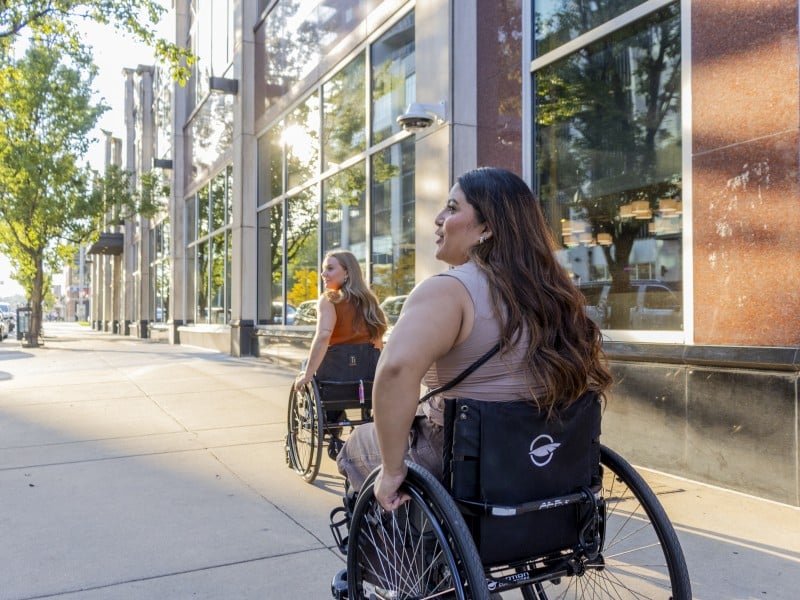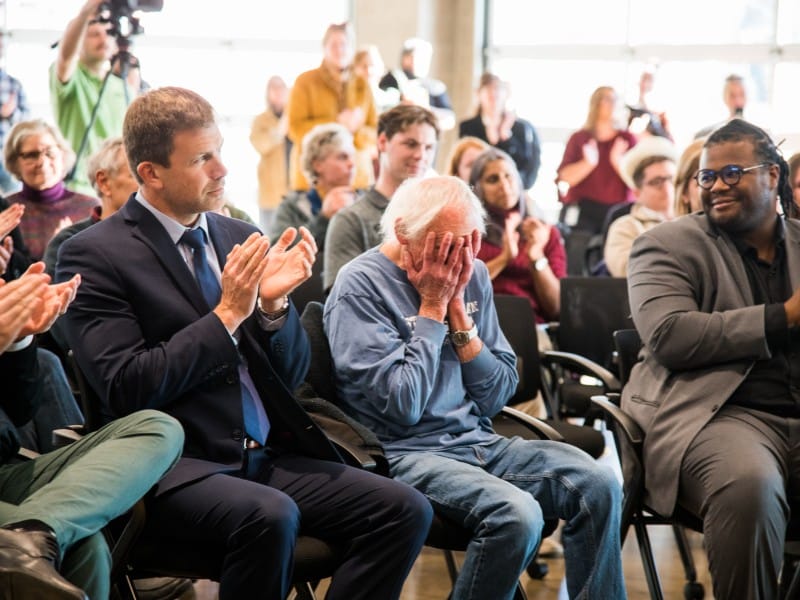Tribal chairman will serve on statewide coronavirus task force on racial disparities
The voices of the state’s Native American population will be represented in the Michigan Coronavirus Task Force on Racial Disparities through a leader with the Nottawaseppi Huron Band of the Potawatomi.

Editor’s note: This story is part of Southwest Michigan Second Wave’s On the Ground Battle Creek series and our ongoing COVID-19 coverage. If you have a story of how the community is responding to the pandemic please let us know here.
The voices of the state’s Native American population will be represented in the Michigan Coronavirus Task Force on Racial Disparities through a leader with the Nottawaseppi Huron Band of the Potawatomi.
Jamie Stuck, NHBP Tribal Council Chairperson, says he was contacted “out of the blue” by Gov. Gretchen Whitmer’s office in late March about becoming a member of the Task Force.
“The Governor sees that it’s very important to tackle the problem of racial disparities and how it impacts minority communities with regard to the pandemic,” Stuck says. “She wanted the Native American perspective on it. She understands the sovereignty of the 12 nations in the State of Michigan and feels that our voice needs to be heard.”
Since she took office, Stuck says Gov. Whitmer has paid close attention to the state’s Native American communities and understands their needs and the disparities they face.
The COVID-19 pandemic has disproportionately impacted communities of color throughout Michigan, according to a press release announcing the formation of the Task Force on which Stuck serves and which is headed by Lt. Gov. Garlin Gilchrist.
“While African Americans represent 13.6% of Michigan’s population, they represent a staggering 40% of the deaths from COVID-19,” the press release says.
“We know that generations of racial disparities and inequality has a detrimental impact on the lives of people across the state,” Gilchrist says. “The coronavirus pandemic has shown this inequity to be particularly damaging, especially in the Black community, where the health of our friends and family has been disproportionately impacted. That’s why we are taking immediate action to assemble some of the greatest minds to tackle this racial injustice now and in the future.”
And the work of the Task Force is dedicated to the memory of Skylar Hebert, a five-year-old girl from Detroit, who was the first child in Michigan to die from complications of the coronavirus. She passed away in late April and had lived in a predominantly African American neighborhood.
“We’re definitely doing this in her honor and definitely looking at how minority communities are dealing with the pandemic,” Stuck says.
“I believe the purpose of my involvement is to shed light on what Native American communities in the state are dealing with,” Stuck says. “We have 12 nations and they’re all dealing with different situations, different wants and needs. This Task Force will give us a measure of how they are responding to this pandemic so that they can get whatever services we need to keep our community safe.”
Stuck says his Executive Team has been diligently working to ensure that NHBP members don’t contract the virus. He says the Cultural Committee has been making and distributing face masks to tribal members.
The NHBPs ability to meet “all of our essential needs as far as tribal needs and services are still strong,” Stuck says. “Our law enforcement, court system, Department of Public Works and Housing departments have been able to cater to the needs of tribal members. Our human and health services have been going strong at Pine Creek Indian Reservation and at our Grand Rapids office.”
The 120-acre reservation, located in Athens Township, is home to about 120 tribal members. Tribal members live all over the United States with about 75 percent living in the Great lakes area.
“We have good healthcare programs for tribal members so needs are met,” Stuck says.
He credits a five-year strategic plan developed by the NHBP community for their ability to keep members safe through the pandemic. While the plan doesn’t specifically address this type of global health crisis, Stuck says it contains numerous emergency preparedness protocols in addition to mitigation plans.
However, not all Native Americans are faring quite as well. Stuck cites the Navajo Nation which he says is dealing with a lot of different issues compared to the NHBP. In late April, the President’s Coronavirus Task Force reported that the Navajo Nation had the highest coronavirus infection rate after New York and New Jersey.
Stuck says Pine Creek is a small reservation and isn’t experiencing the same types of disparities as other tribal communities. The Navajo, for example, have large land bases and are encountering barriers to testing and equipment because they largely rely on government assistance.
Nationally, a team of 80 contact tracers are trying to reach as many tribal members as possible, but they have encountered challenges because not all members have telephones and the geographic area they’re covering is daunting. The Navajo Nation extends into the states of Utah, Arizona and New Mexico, covering more than 27,000 square miles, larger than 10 of the 50 states.
Shawnell Damon, the Navajo epidemiology chief for the COVID-19 strike force, said in a National Public Radio story, that she is trying to train more contact tracers to cover the vast geography and lack of telecommunication infrastructure.
Beyond these issues, there are other ongoing problems that have contributed to the rapid spread of the disease in the Navajo Nation, including the lack of clean, running water in many households which makes frequent hand-washing difficult, unreliable electricity, and hospitals that are few in number and are far apart from each other.
More than 150 years ago, the Navajo and many other tribes signed treaties with the federal government giving up their land in exchange for funding of things such as housing, infrastructure and health care. But, studies and reports have concluded that the federal government has not upheld its part of the treaties.
For example, the federal government spends $2,834 per person on health care in Indian Country, while it spends $9,404 per person on veterans health and $12,744 per person on Medicare, according to a 2018 report presented by the U.S. Civil Rights Commission which studied the continuing federal funding shortfall for Native Americans.
Stuck says those living in Native American communities have a history of pre-existing conditions such as diabetes and heart disease. He says there were health disparities prior to the coronavirus pandemic that were being experienced, but with good direction and planning he says the NHBP has been able to respond in a good way.
“Due to our history we’ve always had higher levels of certain diseases in our community and behavioral health issues because of historical trauma,” Stuck says. “The Native American community is definitely dealing with higher risk factors with all diseases overall.”
The Navajo Nation is among 10 tribes that are suing the federal government to get their share of federal COVID relief money. The NHBP is not a part of that lawsuit but has demonstrated their support of the it. On March 25, Congress passed the $2 trillion Coronavirus Aid, Relief, and Economic Security Act, or CARES Act, which includes $8 billion to help tribes fight the coronavirus.
Stuck says that $8 billion allocation will have to be split up among all of the different tribes within the United States.
Barry Skutt Jr., CEO of NHBP, says he recently learned that the federal government has decided to release 60 percent of the funding based on population with the remaining 40 percent to be released based on employment records and additional expenditures that tribes have incurred to deal with COVID-19. These additional expenditures include the cost of deep cleaning and setting NHBP staff up to work remotely.
“We did receive an award based on population, but I can’t say at this point what that is,” Skutt says.
Stuck says the NHBP is receiving assistance from the Centers for Disease Control and the Federal Emergency Management Agency.
In addition to assistance from the CDC and FEMA, Stuck says he is working with state and federal officials to secure funding to offset losses the NHBP incurs because of the pandemic.
The closure of casinos and other services and the furlough of casino employees has impacted revenue streams for many tribes, some of whom have a revenue stream based solely on economic development. Without these revenues coming in, Stuck says they are faced with the need to continue essential services with no idea about reimbursement.
“The NHBP could definitely use funding from the CARES Act because we’re missing out on two to three months of revenue from the casino. Whatever we can do to get reimbursed is a good thing,” Stuck says.
“We provide services based on our economic development. We don’t have a tax base to provide services,” Stuck says. “For us, having to close down the casino and economic development arm of our operations we are cutting off sources of a lifeline to what we provide our tribal members.
“On the (tribal) government side, this is why we plan and do a comprehensive budget so that we can meet the needs of our tribal members and it comes down to staying in compliance with our five-year plan.”
Stuck and other NHBP leaders are continuing to work to keep their members safe and looking ahead to the re-opening of their FireKeepers Casino. Stuck says he is trying to stay focused on the good working relationships he has at the local, state, and federal levels.
“What I really do appreciate is the communication that has gone on between the tribes and state and in our case local municipalities and the federal government,” he says. “We may not always like the outcome, but we’ve been consulted.”
Too often, he says, Native American communities are left out of conversations.
“We are on calls with county and city leadership about the pandemic to let them know what we’re dealing with,” Stuck says, “and we have a voice in the decisions that are being made.”














